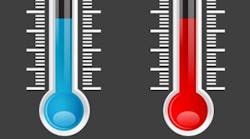Industrial machinery automation systems typically use mostly digital I/O, but some do need to measure and sometimes control analog variables. On the other hand, process skid OEMs routinely deal with multiple analog variables, both for measurement and control. In either case, these analog variables are used to monitor operating conditions, and they’re often used in conjunction with analog outputs for closed-loop control.
An example of monitoring is measurement of temperature on a motor housing. In this case, the temperature is monitored, and the measurement is not used to control the motor, but instead alerts machine operators of a high-temperature condition.
For closed-loop control, an extruder typically has multiple temperature measurement points, and these measurements are used to control heating elements and cooling water valves to maintain the proper temperature of the melted material in the extruder barrel. The temperature is the process variable in the control loop, usually of the PID variety, and the output of the PID controller drives the heating elements and regulates the flow of cooling water.
Selecting the right sensor or instrument to measure each process variable can be a daunting task because there are hundreds, if not thousands, of options on the market from low-cost analog sensors to multivariable smart transmitters. As with many applications, the key is to fit the right component to the task.
For process skids and other OEM applications with multiple analog points of measurement and control, a multivariable instrument often makes sense. "Multivariable transmitters are becoming very popular with process skid builders because they reduce the number of sensors needed in an application, minimize the amount of wiring needed and eliminate the need to make calculations within the main controller," says Jerry Stevens, flow product management lead at Endress+Hauser.
Many process plants purchase skids to produce steam, requiring the OEMs to precisely measure and control steam flow rates and other parameters. "One of our vortex flowmeters measures mass and energy flow of wet, saturated and superheated steam, gases, liquids and cryogenic fluids. The flowmeter measures virtually every steam flow parameter of interest, making it suitable for use in industrial, building, utility and power-generation applications," Stevens explains.
The flowmeter measures volume flow and temperature like a high-end vortex meter. With these parameters and an integrated flow computer, the device can calculate mass flow, corrected volume flow, energy flow and heat-flow difference for a broad variety of liquids and gases. Options extend operating turndown to 100:1, allow for short inlet installations, provide steam-quality warnings, indicate steam dryness fraction and enable in-situ lifecycle management.
"This instrument can replace multiple flowmeters and temperature sensors and does the steam calculations in the transmitter, thus reducing the need to program an external control system," Stevens adds.
Water treatment skids are a common item found in power, pharmaceutical and beverage plants. "Some water treatment and other related processes need to calculate the rH value for optimal control," notes Tracy Doane-Weideman, analytics product manager for Endress+Hauser.
The rH value is the negative logarithm of partial pressure of hydrogen and is an indicator of the oxidation or reducing ability of a process solution, such as when water is treated with an oxidizer such as chlorine. Calculating the rH value can be difficult. "The pH and ORP values of a solution must be measured simultaneously to calculate the rH value, which normally requires two sensors in different locations and an external processor to make the calculation," Doane-Weideman says. "Our sensor simultaneously measures pH and ORP, and automatically calculates rH, eliminating the need for multiple sensors."
Process skids often have multiple analog measurement and control points best served by complex multivariable instruments, but many machines have only single points of analog measurement and are better served by simple measuring devices.
These machines often are controlled by a relatively low-end PLC that can accommodate analog I/O, but not to an extensive level. In these cases, the best choice is often a low-cost instrument that simply measures the desired analog parameter, and transforms this measurement into a 4-20 mA signal that becomes a PLC input.

Leaders relevant to this article:



